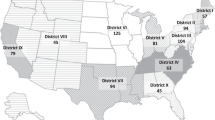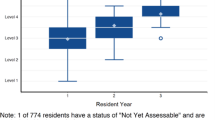Abstract
This is the second article in a seven-part series in the Journal of Perinatology that aims to critically examine the current state of Neonatal-Perinatal Medicine (NPM) fellowship training from the structure and administration of a program, to the clinical and scholarly requirements, and finally to the innovations and future careers awaiting successful graduates. This article focuses on the current clinical requirements; recent changes to the clinical environment and their effect on learning; and additional challenges and opportunities in clinical education.
This is a preview of subscription content, access via your institution
Access options
Subscribe to this journal
Receive 12 print issues and online access
$259.00 per year
only $21.58 per issue
Buy this article
- Purchase on Springer Link
- Instant access to full article PDF
Prices may be subject to local taxes which are calculated during checkout

Similar content being viewed by others
References
Accreditation Council for Graduate Medical Education. ACGME common program requirements (residency) (effective July 1, 2020). 2020. https://www.acgme.org/Portals/0/PFAssets/ProgramRequirements/CPRResidency2020.pdf.
Korbel L, Backes CH Jr., Rivera BK, Mitchell CC, Carbajal MM, Reber K, et al. Pediatric residency graduates preparedness for neonatal-perinatal medicine fellowship: the perspective of first-year fellows. Am J Perinatol. 2020;37:511–8.
Backes CH, Bonachea EM, Rivera BK, Reynolds MM, Kovalchin CE, Reber KM, et al. Preparedness of pediatric residents for fellowship: a survey of US neonatal-perinatal fellowship program directors. J Perinatol. 2016;36:1132–7.
Sawyer T, French H, Ades A, Johnston L. Neonatal-perinatal medicine fellow procedural experience and competency determination: results of a national survey. J Perinatol. 2016;36:570–4.
Accreditation Council for Graduate Medical Education. ACGME program requirements for graduate medical education in neonatal-perinatal medicine (effective July 1, 2020). 2020. https://www.acgme.org/Portals/0/PFAssets/ProgramRequirements/329_NeonatalPerinatalMedicine_2020.pdf?ver=2020-06-29-162707-410.
The American Board of Pediatrics. Subspecialty certifications and admission requirements. 2020. https://www.abp.org/content/subspecialty-certifications-admission-requirements.
Johnston L. Organization of Neonatal Training Program Directors (ONTPD) Survey 2019: NPM Fellowship Landscape; 2019 (Unpublished).
Gaies MG, Landrigan CP, Hafler JP, Sandora TJ. Assessing procedural skills training in pediatric residency programs. Pediatrics. 2007;120:715–22.
Freed GL, Dunham KM, Moran LM, Spera L. Resident work hour changes in children’s hospitals: impact on staffing patterns and workforce needs. Pediatrics. 2012;130:700–4.
Hatch LD, Grubb PH, Lea AS, Walsh WF, Markham MH, Whitney GM, et al. Endotracheal intubation in neonates: a prospective study of adverse safety events in 162 infants. J Pediatr. 2016;168:62–66 e66.
Silverberg MJ, Kory P. Survey of video laryngoscopy use by U.S. critical care fellowship training programs. Ann Am Thorac Soc. 2014;11:1225–9.
American Academy of Pediatrics, American Heart Association. Textbook of neonatal resuscitation., 7th ed. edn. Elk Grove Village, IL: American Academy of Pediatrics and American Heart Association; 2016.
Myers P, Gupta AG. Impact of the revised NRP meconium aspiration guidelines on term infant outcomes. Hospital Pediatrics. 2020;10:295–9.
Wang W, Zhao C, Ji Q, Liu Y, Shen G, Wei L. Prevention of peripherally inserted central line-associated blood stream infections in very low-birth-weight infants by using a central line bundle guideline with a standard checklist: a case control study. BMC Pediatr. 2015;15:69.
Scalese RJ, Obeso VT, Issenberg SB. Simulation technology for skills training and competency assessment in medical education. J Gen Intern Med. 2008;23:46–49.
Nguyen J. Ultrasonography for central catheter placement in the neonatal intensive care unit-a review of utility and practicality. Am J Perinatol. 2016;33:525–30.
Moore CL, Copel JA. Point-of-care ultrasonography. N. Engl J Med. 2011;364:749–57.
Liu J, Copetti R, Sorantin E, Lovrenski J, Rodriguez-Fanjul J, Kurepa D, et al. Protocol and guidelines for point-of-care lung ultrasound in diagnosing neonatal pulmonary diseases based on international expert consensus. J Vis Exp. 2019:145;e58990.
Liu J, Ren XL, Li JJ. POC-LUS guiding pleural puncture drainage to treat neonatal pulmonary atelectasis caused by congenital massive effusion. J Matern Fetal Neonatal Med. 2020;33:174–6.
Singh Y, Katheria A, Tissot C. Functional echocardiography in the neonatal intensive care unit. Indian Pediatr. 2018;55:417–24.
Franta J, Harabor A, Soraisham AS. Ultrasound assessment of umbilical venous catheter migration in preterm infants: a prospective study. Arch Dis Child Fetal Neonatal Ed. 2017;102:F251–F255.
Katheria AC, Fleming SE, Kim JH. A randomized controlled trial of ultrasound-guided peripherally inserted central catheters compared with standard radiograph in neonates. J Perinatol. 2013;33:791–4.
Saul D, Ajayi S, Schutzman DL, Horrow MM. Sonography for complete evaluation of neonatal intensive care unit central support devices: a pilot study. J Ultrasound Med. 2016;35:1465–73.
Zaghloul N, Watkins L, Choi-Rosen J, Perveen S, Kurepa D. The superiority of point of care ultrasound in localizing central venous line tip position over time. Eur J Pediatr. 2019;178:173–9.
Nguyen J, Amirnovin R, Ramanathan R, Noori S. The state of point-of-care ultrasonography use and training in neonatal-perinatal medicine and pediatric critical care medicine fellowship programs. J Perinatol. 2016;36:972–6.
Michel MC, Colaizy TT, Klein JM, Segar JL, Bell EF. Causes and circumstances of death in a neonatal unit over 20 years. Pediatr Res. 2018;83:829–33.
Hellmann J, Knighton R, Lee SK, Shah PS. Neonatal deaths: prospective exploration of the causes and process of end-of-life decisions. Arch Dis Child Fetal Neonatal Ed. 2016;101:F102–107.
Weiner J, Sharma J, Lantos J, Kilbride H. How infants die in the neonatal intensive care unit: trends from 1999 through 2008. Arch Pediatr Adolesc Med. 2011;165:630–4.
Smailhodzic E, Hooijsma W, Boonstra A, Langley DJ. Social media use in healthcare: a systematic review of effects on patients and on their relationship with healthcare professionals. BMC Health Serv Res. 2016;16:442.
Wald HS, Dube CE, Anthony DC. Untangling the Web-the impact of Internet use on health care and the physician-patient relationship. Patient Educ Couns. 2007;68:218–24.
Extracorporeal Life Support Organization (ELSO). ECLS Registry Report International Summary; 2020.
Accreditation Council for Graduate Medical Education. ACGME program requirements for graduate medical education in pediatrics (effective July 1, 2020). 2020. https://www.acgme.org/Portals/0/PFAssets/ProgramRequirements/320_Pediatrics_2020.pdf?ver=2020-06-29-162726-647.
Metcalfe P. Teaching neonatal circumcision. Can Urol Assoc J. 2013;7:265.
Freed GL, Dunham KM, Moran LM, Spera L, McGuinness GA, Stevenson DK. Fellowship program directors perspectives on fellowship training. Pediatrics. 2014;133:S64–S69.
Smith CC, McCormick I, Huang GC. The clinician-educator track: training internal medicine residents as clinician-educators. Acad Med. 2014;89:888–91.
Jenkins S, Bryant C. Clinician scientist fellows scheme evaluation. 2012. https://acmedsci.ac.uk/file-download/35282-CSFSchem.pdf.
Blumenthal DM, Bernard K, Bohnen J, Bohmer R. Addressing the leadership gap in medicine: residents’ need for systematic leadership development training. Acad Med. 2012;87:513–22.
Blumenthal DM, Bernard K, Fraser TN, Bohnen J, Zeidman J, Stone VE. Implementing a pilot leadership course for internal medicine residents: design considerations, participant impressions, and lessons learned. BMC Med Educ. 2014;14:257.
Natesan S, Bailitz J, King A, Krzyzaniak SM, Kennedy SK, Kim AJ, et al. Clinical teaching: an evidence-based guide to best practices from the council of emergency medicine residency directors. West J Emerg Med. 2020;21:985–98.
Izatt S, Gray M, Dadiz R, French H. Development and implementation of a national neonatology flipped classroom curriculum. J Graduate Med Educ. 2019;11:335–6.
ONTPD Fellowship Directors Writing Group
Heather French7, Kris Reber8, Melissa Bauserman9, Misty Good10, Brittany Schwarz11, Allison Payne12, Melissa Carbajal13, Robert Angert1, Maria Gillam-Krakauer14, Jotishna Sharma15, Elizabeth Bonachea8, Jennifer Trzaski16, Lindsay Johnston17, Patricia Chess18,19, Rita Dadiz18, Josephine Enciso20, Mackenzie Frost7, Megan Gray21, Sara Kane22, Autumn Kiefer23, Kristen Leeman24, Sabrina Malik25, Patrick Myers26, Deirdre O’Reilly27, Taylor Sawyer21, M. Cody Smith23, Kate Stanley28, Margarita Vasquez29, Jennifer Wambach10
Author information
Authors and Affiliations
Consortia
Corresponding author
Ethics declarations
Conflict of interest
The authors declare no competing interests.
Additional information
Publisher’s note Springer Nature remains neutral with regard to jurisdictional claims in published maps and institutional affiliations.
Members of the ONTPD Fellowship Directors Writing Group are listed below Conclusion.
Rights and permissions
About this article
Cite this article
Cicalese, E., Wraight, C.L., Falck, A.J. et al. Essentials of Neonatal-Perinatal Medicine fellowship: part 2 - clinical education and experience. J Perinatol 42, 410–415 (2022). https://doi.org/10.1038/s41372-021-01042-5
Received:
Revised:
Accepted:
Published:
Issue Date:
DOI: https://doi.org/10.1038/s41372-021-01042-5



